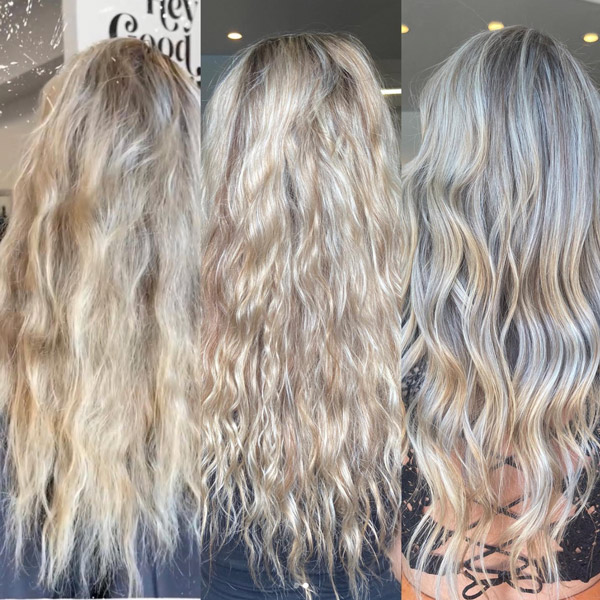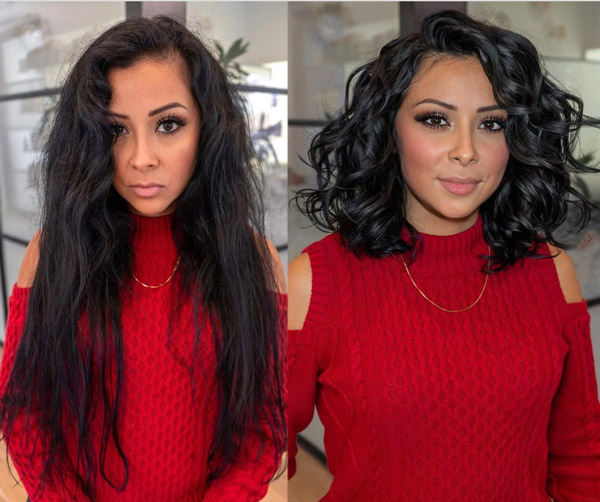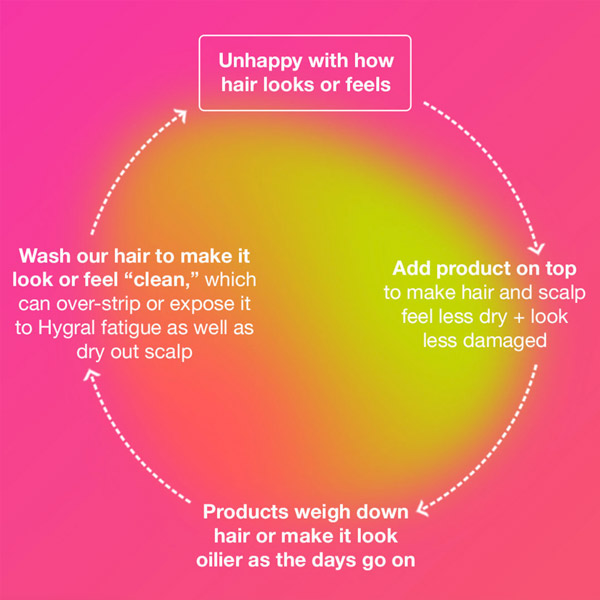How To Fix Hair Damage: 3 Ways To Avoid Disaster
How To Spot 3 Types of Hair Damage and How To Treat Each
It only takes one wrong move (or a misleading consultation) for a client’s hair to become damaged in your chair. To help you prevent and repair damage, we’re breaking down the science behind it, tips for identifying it in the salon and the preventative steps to take for avoiding disaster.
Keep scrolling for three types of hair damage: what it looks like, how it happens and what you (and your clients) can do to repair and maintain healthy strands.
Repair damage in just FOUR minutes: Click here!
Understanding where damage happens
The only way to prevent and fix damage is to understand why it happens in the first place. Or better yet—where it happens.
Most major damage occurs at the cortex or the innermost layer of the hair. Some products address surface-level concerns on the cuticle. Some work to reconnect broken disulfide bonds—but there’s another type of breakage responsible for your client’s hair health.
Hair’s core strength and elasticity comes from the keratin chains at hair’s innermost layer. When these keratin chains are weakened, the hair loses its ability to withstand chemical services—resulting in breakage. These chains and bonds need to be reconnected to truly renew hair and combat damage.
Related: How to Permanently Heal Damaged Hair
Identifying Hair Damage: What it looks like and how to prevent it
Now that we know where damage can happen, let’s breakdown how it happens and what you can do to prevent it:
#1 Color damage: How to spot & fix it
What it looks like: Breakage, overprocessed (stretchy) hair, lackluster results
We know you do everything you can to prevent damage during a color service. But if the client’s hair is already compromised, damage can happen. Here’s why:
- Lightener can weaken bonds: Bleach contains peroxides—also known as oxidizing agents—that can stress the hair’s disulfide bonds and keratin chains (aka what’s responsible for hair’s holistic health.)
- Hair color can alter the hair’s pH level: Hair color often contains ammonia, which raises the hair’s pH level and can cause the cuticle to swell. Swelling weakens the cuticle of the hair, which can cause permanent damage over time.

Solution: Strengthen the hair before a color application to prevent damage.
Prep hair with the Professional Molecular Repair Mist from K18 Hair. Why? The mist is formulated with K18Peptide™ which travels to the inner cortex of the hair and helps reconnect broken keratin chains. This strengthens and renews damaged hair in four minutes for the healthiest canvas possible to undergo the color service.
Pro Tip: Ensure long-lasting results by applying the K18 Hair Leave-In Molecular Repair Hair Mask before toning to avoid fast-fading color.
Balayage without breakage? Watch @adina_pignatare’s pro tips in this quickie tutorial!
View this post on Instagram
Related: Extreme Color Correction: Damage Blonde to Gray
#2 Chemical damage: How to spot & fix it
What it looks like: Brittle strands, breakage, frizzy results
Services like perms and relaxers rely on chemicals to alter the hair strand’s natural shape. This can leave the hair in a vulnerable state and more susceptible to damage. Here’s a deeper look:
- Perms: Ingredients like Ammonium Thioglycolate break down and reshape disulfide bonds (aka the steps) from straight to wavy or curly. The reformed bonds can put stress on the hair to hold the new, desired shape.
- Relaxers: This service loosens the natural curl pattern by disrupting and reconfiguring disulfide bonds to a smoother, straighter shape. Hydrogen Peroxide is applied to help the hair maintain the new look, but can also leave the hair weak and cause strands to lose elasticity.

Solution: Use a product that not only protects the hair but helps maintain long-lasting results.
Spoke + Weal founder Christine Thompson (@chistinethompsonhair) preps her chemical services with the Professional Molecular Hair Mist. Why? “The Molecular Hair Mist protects the hair during the chemical service but also helps to lock in that curl pattern and give the end results a nice bounce. Plus, it maintains the integrity of the hair,” she explains.
Pro Tip: For a perm, avoid weighing down fresh curls with the Leave-In Molecular Repair Hair Mask. Instead, prep for styling by reapplying the Professional Molecular Hair Mist after rinsing the neutralizer from the hair. Then, send clients home with the Leave-In Molecular Repair Mask to maintain frizz-free curls after the first wash.
Watch the video below for FAST perm dos + don’ts!
View this post on Instagram
#3 Heat damage: How to spot & fix it
What it looks like: Dull color, breakage, dry, frizzy ends
Hair pros know: heat damage almost always happens at home. But educating clients on how to style their hair safely and giving them the products they need to avoid further damage happens in the salon. Here’s an easy checklist for explaining heat damage to clients:
- Excessive heat damage can leave hair dry and frizzy. Over time, heat can damage the keratin chains within the cortex. This will cause hair to lose shine and color to appear lackluster.
- Heat styling wet hair can cause the cuticle to deteriorate and cause serious breakage. Known as “bubble hair,” water molecules can become trapped between keratin chains, causing bubbles to form in the hair shaft which results in damage.

Solution: Show clients how to properly prep the hair for heat styling and send them home with a product that will prevent future damage.
Don’t let your client get overwhelmed when choosing the right product. Instead, suggest a product that repairs all hair types and is easy to use. The K18 Leave-In Molecular Repair Hair Mask not only repairs existing damage in only four minutes, but also helps keep hair strong enough to withstand future services.
Hit play to watch @glenn_hairartist87’s maintain his client’s healthy strands while heat styling!
View this post on Instagram
Want exclusive access to professional pricing? Become a K18 Pro here!
More from
K18 Hair
-
Best of the Year
The Most Influential Celebrities in Hair in 2024
-
Monthly Product Launch List
11 Hair Gift Sets For The Hair Obsessed People On Your List
-
Here’s how the Hair Industry Celebrated Pride Month
-
Monthly Product Launch List
The Best Hair Launches Of March 2024
-
AirWash™ Dry Shampoo
-
Blonde
Virgin To Dimensional Blonde Blend
-
Brunette
Rich Beige Brunette
-
Curls
How To Eliminate The “Shelf” In Curly Cuts
-
Product Launches
Damage Shield Protective Conditioner
-
News
How Maui Hairdressers Are Rebuilding Post-Lahaina Fires
-
Copper
Rooted Cherry Curls
-
Barbering
How To Style The Biggest Men’s Summer Trends
-
Business
15 FREE Classes To Take For Hairstylist Appreciation Week
-
Product Launches
Spring 2023’s Pro Beauty Product Launch
-
Oil
Molecular Repair Hair Oil
-
Brunette
Trend Breakdown: Hailey Bieber’s Glazed Brunette
-
BTC Hair Trend Report
Your Complete Guide To Color Blocking
-
BTC Hair Trend Report
Natural-Toned Color Blocking
-
Blonde
TikTok Star Alix Earle’s Warm, Golden Bronde
-
Color Protecting
You’re Using K18 Wrong: Here’s What You Need To Know
-
Celebrity
Paramore’s Hayley Williams Has Opened Her Hair Salon
-
Distributor
K18 Hair Launches At SalonCentric
-
Clarifying
PEPTIDE PREP™ Pro Chelating Hair Complex
-
#ONESHOT HAIR AWARDS
The BTC Show 2022: 10 Things We Saw







